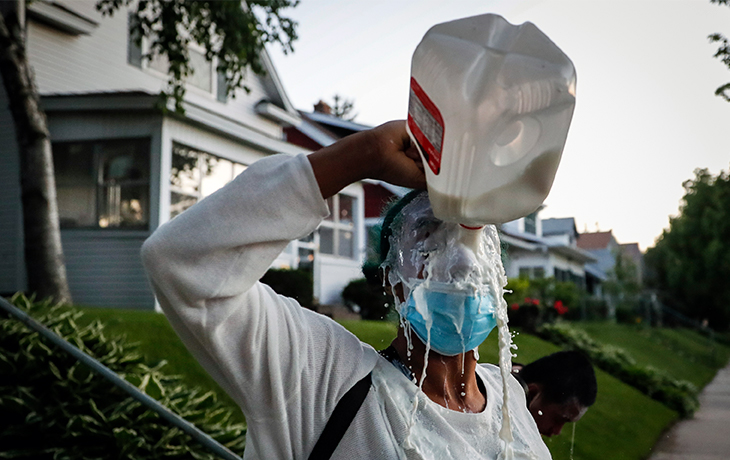You may have seen people at protests dumping milk in their eyes. Newscasters often say these people are washing out tear gas or pepper spray. But does that trick actually work? Or is it just another myth about how to treat chemical irritants? We spoke to the experts and did some digging to find out the truth.
The punchline: Milk helps a bit with pepper spray, but not at all with tear gas. Studies show that milk and other tricks don’t offer much extra value—the main thing to do with either irritant is flush with water and wait.
In the above video from NBC, police fire tear gas at protesters in Minneapolis. Protesters can then be seen pouring milk over each other’s eyes.
A doctor’s view
First, we wondered if putting milk in your eyes would do any harm.
So we reached out to Paul A. Edwards, MD. Dr. Edwards is the President of The Michigan Society of Eye Physicians and Surgeons and Chairman of Opthalmology at Henry Ford Hospital in Detroit, Michigan.
“[Milk] really doesn’t do much harm unless it’s been sitting out for a long time and has bacteria. But if it’s really fresh, it’s unlikely that it’s going to harm you.” On a hot summer day, then, if you’re not sure where the milk is from or if it might be old, you may want to skip the milk and use water instead.
In terms of effectiveness against crowd control chemicals: “My understanding is that milk doesn’t really do much to neutralize the chemicals in tear gas. What it does is act as a lavage,” Dr. Edwards said over the phone. “So basically you’re just washing the stuff away. And you could do the same thing with water—one bottle of water or two bottles of water.”
“It works with pepper spray, though. You can neutralize those oils and flush them out quicker with milk. Water isn’t as effective at washing those oils away.”
Dr. Edwards also endorses the use of goggles, a face shield, or a full respirator if you plan to attend any protests. That’s especially the case in the time of COVID-19. Tear gas makes people cough, and coughing people spread COVID-19 to those around them.
Why does milk neutralize pepper spray but not tear gas?
They (usually) aren’t the same chemicals. Pepper spray is made with capsaicin, the same chemical that makes hot chili peppers hot.
See that black and white tail on the capsaicin structure, below? That’s made up of hydrogen and carbon, and it makes capsaicin behave like an oil.

Milk from mammals like cows and goats contains casein, which dissolves hydrocarbons. That’s why, in theory, milk should be able to dissolve pepper spray and relieve pain.
Police don’t usually announce the chemical structure of their weapons before spraying you down with them, so it’s hard to know what’s being used in the field. The best way you can tell is by looking at how the chemical was delivered — was it a targeted stream or a larger cloud? Targeted streams are usually pepper spray and lingering clouds are usually tear gas. Pepper spray also tends to affect you for longer, so if it’s been an hour or more and you’re still hurting, milk might be worth a try.
An exception to the general “milk works for pepper spray but not tear gas” rule is that some tear gas does contain pepper spray. Most pepper spray is a targeted stream against one person, but there are a few versions that form larger clouds used to disperse crowds. So if someone you know insists that milk has worked against tear gas, they might have experienced a rare tear gas that included capsaicin.
And, in the end, it won’t hurt you to use (safe) milk regardless. Even though it might not help neutralize the chemicals, it might at least give you a cooling feeling for a while.
The reason things like milk/yogurt help is cause they have a cooling effect. Don’t rub your eyes, don’t touch your face. When you’re gassed, the chemicals stay on your skin & clothing and spread to anything you touch. Saline wash your face then cold shower when youre home.
— Rana Nazzal رنا نزال (@rananazzalh) May 31, 2020
Medical trials and more sources
There haven’t been any known medical trials on milk as a treatment for tear gas. But in a randomized controlled experiment in 2008, researchers tested milk and other substances against pepper spray. Specifically, they tried:
- aluminum hydroxide-magnesium hydroxide [Maalox]
- 2% lidocaine gel
- baby shampoo
- milk
- water
In the end, none of those other substances commonly used to treat pepper spray and tear gas worked any better than the others. The authors concluded, “In this study, there was no significant difference in pain relief provided by five different treatment regimens. Time after exposure appeared to be the best predictor for decrease in pain.”
In other words, despite the common advice and the chemical structure, their study found that milk didn’t work any better than water. Time was simply the best treatment.
So, who’s right, the trials or the anecdotal advice from doctors and street medics? Given the somewhat-conflicting data, we tend to favor the advice from boots-on-the ground medical pros and protestors: milk isn’t a magical treatment, but it might make you feel better via cooling and can help break down or flush out pepper spray oils.
Additional sources:
(Note: Some of these sources are political since they’re written for political protests. These links aren’t necessarily endorsements of whatever politics you find when clicking through to one of these other sites.)


You are reporting the comment """ by on